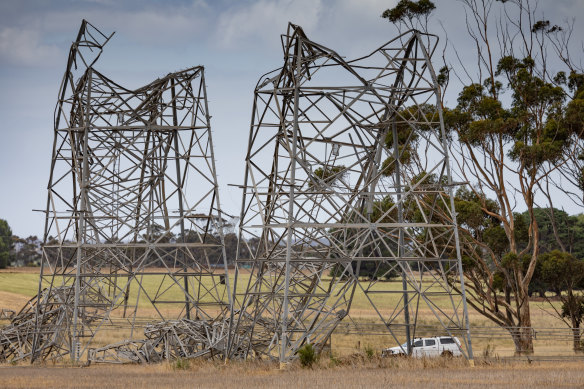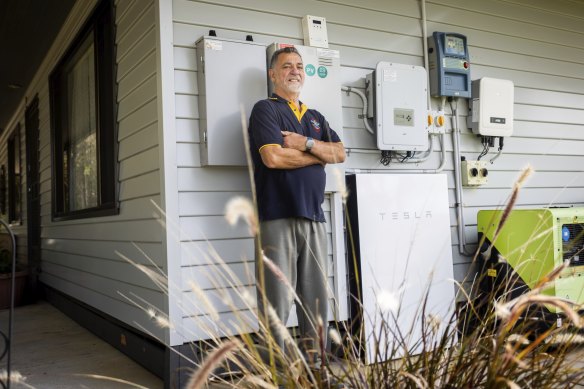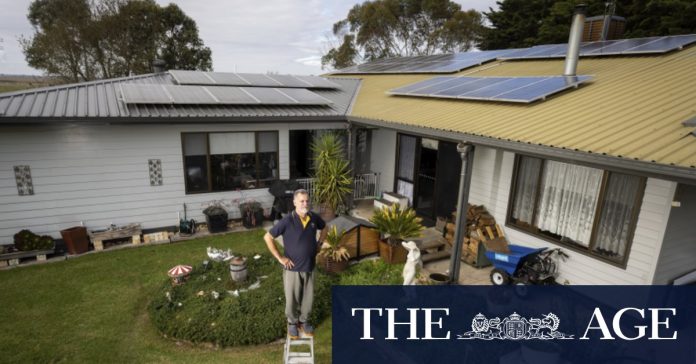[ad_1]
On a sweltering February morning, staff at electricity supplier AGL were preparing for a potentially catastrophic day on the grid.
There was good reason to worry: home air-conditioners were driving enormous demand for power, just as storms, bushfires and lightning were about to bring the system to its knees. At 1pm, high-voltage transmission towers of galvanised steel were crumpled in wild winds near Geelong, while smaller poles came crashing down across the network. Two wind farms suddenly tripped offline, and so did all four units at AGL’s giant Loy Yang A coal-fired power station. Before long, the power had gone out at more than half a million Victorian homes.
In times like these, when the power grid needs an urgent boost, a signal arrives at Tony Debono’s house within a tenth of a second and activates a box on the wall next to his electricity meter.
His property in Cobains, a dairy farming town east of Melbourne, forms part of one of Australia’s newest power plants, which isn’t really a power plant at all – at least, not how we traditionally think of them.
Instead, it’s a virtual power plant: a far-flung network of privately owned rooftop solar panels and batteries dispersed across thousands of houses on the eastern seaboard. In return for a credit on their bills, Debono and other customers like him have agreed to allow their power providers to take control of their devices at certain times and utilise the combined force of their stored solar energy.

Power lines came down in the You Yangs following windy and stormy weather in Melbourne in February.Credit: Jason South
“When there’s a critical need, they can draw some power off my system onto the grid,” says Debono. “And I’ve got no problem with that.”
As utilities such as AGL, Origin Energy and EnergyAustralia prepare to close down their last remaining coal-fired power stations in the coming years, the industry is shifting much of its focus to an important question: how do you balance an energy system in a world of cleaner but less-consistent renewable energy?
The ability to aggregate large numbers of customers’ solar panels and batteries to treat them like a single “virtual” power plant may hold part of the solution. When it’s not sunny or breezy, and not enough power is available in the grid, utilities can tap these virtual power sources to dispatch bursts of solar energy held in customers’ batteries to address imbalances and keep the network stable. If participating homes are fitted with intelligent appliances as well, such as electric hot water systems, these can also play a role by powering down to minimise demand. So too can large businesses, such as factories, who have agreed to free up the grid when conditions are tight.
Loading
Obviously, a single rooftop solar system and a home battery can’t do the job of a power station, says the Australian Renewable Energy Agency (ARENA), which has funded many of the country’s early virtual power plant trials, “but what about 1000 home batteries, or 10,000, or a million?”
The energy market operator predicts the capacity of virtual power plants is set to surge, especially as all-electric homes with batteries, rechargeable electric vehicles, solar, and energy-management solutions keep growing in popularity. By 2050, it says, co-ordinated consumer energy resources could account for 65 per cent of the entire storage capacity on the east-coast grid.
Origin Energy, which runs Australia’s biggest virtual power plant, called Loop, thinks the technology’s scale and potential have been “completely underestimated”.
“When we announced we’d have a two-gigawatt virtual power plant by 2026, most people asked us what it was,” Origin chief executive Frank Calabria says. With Loop’s capacity sitting above 1.2 gigawatts today – even before widespread adoption of home batteries and electric vehicles – it’s “becoming very real very quickly”, he says.
To some in the energy industry, the response to Victoria’s extreme weather and blackouts on February 13 gave the clearest demonstration yet of virtual power plants’ emerging value.
As staff on the AGL trading floor swung into action that day, scanning giant monitors and dispatching signals to crank up their available gas, hydro, wind and solar units, AGL’s head of virtual power plant operations, Caitlin Trethewy, and her team were able to activate their assets in much the same way.
Between 2pm and 8pm, more than 20,000 residential customers were involved in helping stabilise the grid and powering about 500 Victorian homes, according to Trethewy.

More customers like Tony Debono have signed up to be fitted with solar panels and storage batteries, which enables utilities to aggregate stored solar energy and use it to stabilise the power grid when needed.Credit: Paul Jeffers
“Some of those were customers with home batteries that were able to respond within 100 milliseconds to frequency imbalance in the grid and offer power,” she says. “We also had customers on our ‘peak energy rewards’ product, where AGL sends customers a text message asking them to reduce energy consumption within a specific window of time.”
AGL’s virtual power plant, which began as a trial in South Australia with ARENA funding to install 1000 behind-the-meter batteries and experiment with software to orchestrate them, has been scaled up significantly. Today, it spans every state in which AGL retails, and includes a range of assets across residential and business premises. At the last count, AGL now has 1.1 gigawatts of decentralised assets connected via a cloud-based platform, and is on track to hit 1.8 gigawatts by 2027.
For the power grids of the future, which will require more flexibility to balance supply and demand, virtual power plants could be “game-changing”, says Trethewy.
For customers who have invested in home energy assets, they can also be rewarding. “We, on the customer’s behalf, aggregate their assets, participate in wholesale energy markets to generate more value,” she says. “Then we’re able to share that value back with the customer.”
Loading
As Debono started approaching retirement, he had one main priority: “I wanted to make my bills cheaper,” he says. “So I invested in a solar system.” First, he went for a 4.5-kilowatt system, which reduced his bills by about half. Now he’s increased it to 10 kilowatts. On his gable roof, most of his solar panels are facing north, where they can produce the most electricity, and others are facing west for when the sun is setting. He’s also installed a home battery (a Tesla Powerwall 2), a pair of five-kilowatt inverters and a back-up generator. All up, it has cost him about $35,000.
“People asked, ‘What’s the payback time on that?’ but I wasn’t worried about the payback time, I was more worried about having cheaper bills,” Debono says.
Average electricity prices have been sharply rising across Australia, driven by ageing coal-fired power station breakdowns and higher fossil fuel prices following Russia’s invasion of Ukraine in 2022. But by feeding his excess rooftop solar into the grid, and participating in AGL’s virtual power plant, Debono earns enough bill credits that he makes money each month.
“For the past year, I haven’t paid a power bill at all,” he says.
Virtual power plant programs, and the growing number of retail offers being built around them, are coming at a critical moment in the energy transition.
Australia has emerged a world-leader in rooftop solar uptake on a per-capita basis, with more than one-third of homes now fitted with solar panels. Home batteries are also quickly rising in popularity, and the uptake of electric vehicles whose batteries could also be used to supply the grid, is expected to unlock even greater capacity.
“It’s a massive growth story,” says Leon Chanter, ARENA’s associate director of business development. “And the projections for distribution-level consumer energy resources … expect it to continue to grow.”
‘I wanted to make my bills cheaper … So I invested in a solar system.’
Tony Debono
What’s important now, he says, is developing the systems and regulatory frameworks to maximise all of this distributed energy potential by orchestrating household assets, encouraging greater consumer participation and avoiding having to curtail output when there is an oversupply of solar.
Loading
“Having virtual power plants and orchestrated distributed energy resource solutions in place allows a household to maximise the value of its energy, and that means a lower-cost future,” he says.
A consumer energy resources road map, aiming to establish nationally consistent rules to boost consumers’ ability to export solar and enable vehicle-to-grid technologies, will be reviewed by state and federal energy ministers in July.
Virtual power plants alone won’t take away from the urgent need for more grid-scale energy projects, like wind and solar farms, big batteries, pumped hydro and transmission lines, which will be critical to compensate for an approaching wave of coal-fired power station closures.
But what they will do, says Origin Energy’s Frank Calabria, is help reshape the electricity market into one that’s better-equipped to respond to more dispersed energy sources, as well as customers’ growing appetite to take part in, and benefit from, the clean energy transition.
“As the price points of batteries go down, as more people buy electric vehicles and they want to get the benefit of sharing that, we just think it’s an enormous opportunity,” Calabria says.
“That doesn’t take away from grid-based load overall, but I can assure you it’s going to be an incredibly important part of matching supply and demand as more renewables come into the system.”
The Business Briefing newsletter delivers major stories, exclusive coverage and expert opinion. Sign up to get it every weekday morning.
[ad_2]
Source link


